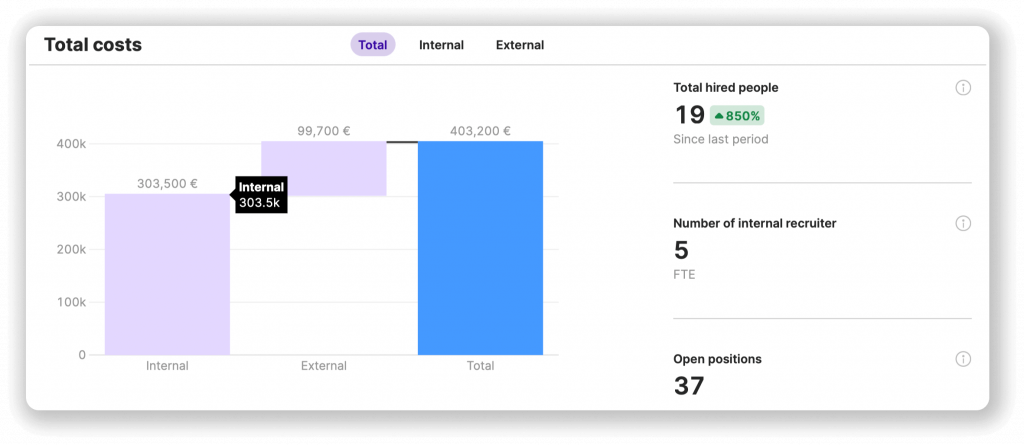23 Feb

Managing and organizing HR data is one of the most challenging tasks for CHROs and people operations managers. In HR analytics and decision-making, data quality is crucial. To make the right hiring, firing, promotion, etc. decisions, it is imperative to ensure employee data is accurate and complete.
Improving data quality is therefore an essential step to improve the accuracy of HR analytics. This post presents several methods that can be used to improve the quality of HR data. Implementing these methods in your organization will help to perform better and more reliable HR analytics.
How can HR departments improve data quality to perform robust analysis and make informed decisions?
HR departments are responsible for collecting and managing data. To ensure they can use that data to make informed decisions, they need to ensure the data is of good quality. The best way for HR departments to improve the quality of their data is to establish clear processes for collecting and storing it. That way, they can track history and provide the context in case information needs to be updated later. In addition, implementing automated data checks can help highlight discrepancies that could affect the accuracy of the analysis so that these issues can be quickly addressed. Ultimately, by improving the quality of their HR-related data, HR departments can be confident that their analytics are reliable and accurate, leading to better decision outcomes for all stakeholders in the long run. You can find more information about How to set up your HR Tech Stack to enable People Analytics in our previous post.
Why is high data quality so important for HR analytics and what impact does it have on overall business performance?
High data quality is essential for any HR analytics, as it directly impacts the accuracy, transparency, and completeness of the analyses performed. It is also extremely important for maintaining the credibility of the insights gained from HR analytics and minimizing the risks associated with strategic and tactical decision-making. High-quality data gives organizations confidence that they can accurately interpret the data and derive meaningful insights that improve overall business performance.
What steps do HR departments need to take to improve data quality to drive better results?
One of the most important tasks for an HR department is to establish processes to improve data quality. A proven approach is to implement a data model to better structure and standardize processes. To ensure the accuracy and completeness of the data, you should use automated software solutions that constantly check the data for discrepancies and errors. This way, you don’t have to manually check every piece of the information yourself, but the software does it for you. This not only improves the quality of the results but also saves time and effort. Most importantly, improved results mean better decision-making for all departments in the company!
How can HR analysts ensure that their analyses are based on clean, valid and up-to-date data to deliver accurate results and make informed recommendations?
To ensure that HR analysts deliver high-quality analytics results, automated data quality solutions must be implemented. These include the detection and resolution of data duplicates and the review of data to ensure a consistent definition of all raw data used in the analysis. It is also important to determine the sources of the data to ensure that the datasets are current. It is also necessary to assess whether there are sufficient data points to draw the correct conclusions and make correct calculations of the analysis results.
Conclusion – Why investing in improving the HR data basis is worthwhile and what advantages result for companies.
A robust HR data foundation is critical to gaining insights that inform decision-making processes. Technology can bring immense benefits here: The manual effort required to cleanse and collect data is automated, freeing up more resources to pursue HR goals. This also fosters appropriate data understanding and data literacy within the organization, creating a solid foundation for analytics. This allows organizations to efficiently perform real-time analytics and improve their HR operations. Investments in technology to support HR data collection are therefore well spent and worthwhile, resulting in tangible benefits for organizations in many ways.
If you want to read more on the topic of data quality, we recommend reading Spiceworks’ article here: 6 Questions You Need to Ask About Your HR Data Quality
HR data is essential to making informed decisions about your workforce, but it’s only as good as the quality of the data. If you want to improve your HR analytics and get better results, you need to invest in improving the quality of your HR data. By taking steps to improve data collection and increase accuracy, you can ensure that your HR analytics are based on clean, valid, and up-to-date data – giving you accurate insights and reliable recommendations. You can find more information about how to get started with People Analytics in our Essential Guide to Get Started.
How peopleIX helps you to bring your data quality to the best level
At peopleIX, we use an algorithm that detects all your data quality issues within minutes and even gives you suggested values that you just have to accept. The errors detected by the algorithm include:
1. Missing Values
The data health algorithm does not simply identify all empty fields, as in the case of HR data, some fields may intentionally be left blank. The algorithm is designed to differentiate between intentionally empty fields and genuinely missing values by following logical rules. For example, if a person is hired but no offer date is entered, the algorithm recognizes that logically a value is missing in this field.
2. Duplicate values
Duplicates refers to instances where there are duplicates or inconsistencies in the labels of the data. For example, if one employee has their nationality listed as “German” and another employee has it listed as “Deutsch,” it is important to merge and standardize these values into a single category.
3. Irrelevant values
Irrelevant values refer to a special case where specific data entries or individuals need to be excluded or treated differently during analysis due to their unique characteristics or circumstances. For example, you create 5 access accounts for external recruiters in your HCM/HRIS system. While these accounts are treated as employees in your HCM/HRIS system, they are not meant for the desired analysis and therefore should be excluded from data in the peopleIX platform.
4. Format
The algorithm checks each data field for the format and has stored information about which data field is allowed to have which format. For example, an error is detected for the date if it contains letters.
5. Likely erroneous values
For some fields, certain lower and upper limits are defined. For example, a data quality issue is detected if the age is below X or above Y years, as it is very likely that an error occurred here.
Once our algorithm has processed the data of all your applicants and employees, all detected data quality issues are listed in the peopleIX platform. You can then fix them within the shortest possible time, as our algorithm directly suggests the most likely correct values.
peopleIX Data Health Score
In addition, we provide you with a data health score for all metrics and dashboards. The data health score indicates how clean your data is. Its purpose is to give a quick overview of the reliability and accuracy of your data in a single metric. The score can range from 0 to 100, with a higher score representing better data quality. This allows you to always analyze the meaningfulness of each metric and dashboard in light of the data quality.
Get started
peopleIX connects all your HRIS, ATS and other HR data sources to enable real-time people analytics. Of course, we ensure beforehand with our algorithm that the analyses are accurate and reliable through high data quality. Get a personalized demo around your unique pain points and discuss your company’s specific needs. Find out how peopleIX can help you on your people analytics journey. Or discover our use cases in the areas of people, recruiting, retention and DEI.
Recent Posts

Investing in Your HR Team: The Impact on Company Growth
January 31, 2024Categories
- Analytics (2)
- Collaboration (1)
- Customer Sucess Stories (1)
- Data Management (1)
- Foundations (9)
- Human Resources (HR) (3)
- Platform (1)
- Recession Times (2)
- Tech Stack (1)
- Use Cases (4)
PRODUCT
People Planning & Scenarios
Sharing & Collaboration
RESOURCES
LEVEL UP
STAY IN THE LOOP
Copyright © 2024 peopleIX GmbH. All rights reserved.


